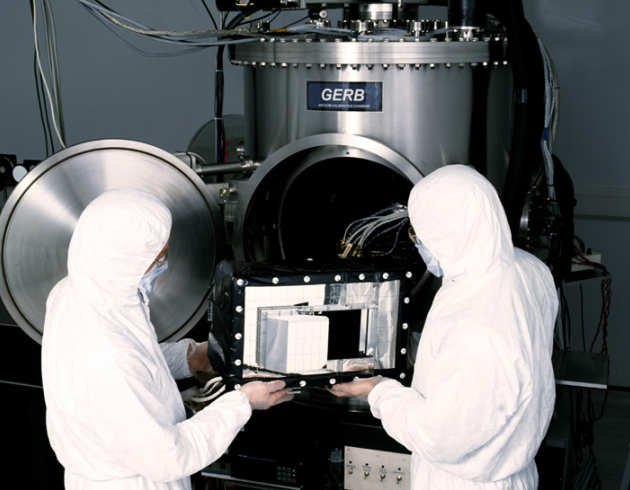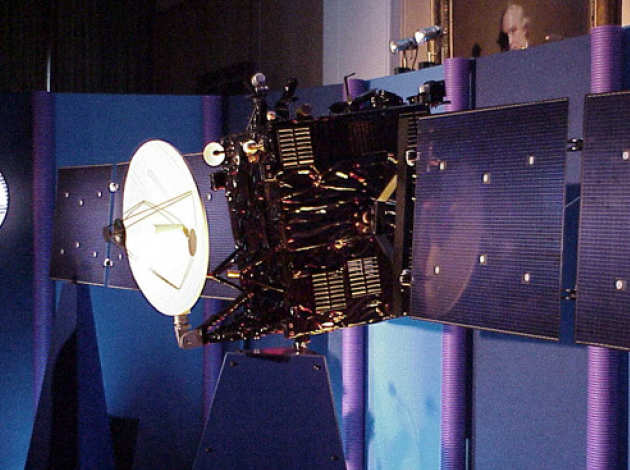Final Approval for GERB2/3, Delivery of GERB1
 Final agreement has been reached with the Eumetsat organisation to fly GERB instruments on their Meteosat Second Generation MSG-2 and MSG-3 spacecraft in 2002 and 2007 respectively. GERB is an instrument designed to make accurate measurements of the Earth's radiation budget from space and is already going to be flown on the MSG-1 spacecraft in October next year. See our GERB web page for more details. Professor John Harries of SPAT is the principal investigator for GERB and leads the international science team. SPAT is also responsible for calibration of the GERB instruments, which is done in the department's new Earth Observation Calibration Facility (EOCF).
Final agreement has been reached with the Eumetsat organisation to fly GERB instruments on their Meteosat Second Generation MSG-2 and MSG-3 spacecraft in 2002 and 2007 respectively. GERB is an instrument designed to make accurate measurements of the Earth's radiation budget from space and is already going to be flown on the MSG-1 spacecraft in October next year. See our GERB web page for more details. Professor John Harries of SPAT is the principal investigator for GERB and leads the international science team. SPAT is also responsible for calibration of the GERB instruments, which is done in the department's new Earth Observation Calibration Facility (EOCF).
Last month, following calibration in the EOCF in March/April, GERB1 was delivered to the spacecraft contractor Alcatel in Cannes, France where it will be integrated onto the MSG-1 spacecraft. The photograph to the right shows Steve Kellock and Ray Wrigley installing the GERB1 instrument optical unit in the ultra-clean, vacuum calibration system in the EOCF.
Steve Kellock 23rd June 1999
Rosetta Spacecraft Unveiled in London
 The final design of the Rosetta spacecraft, ESA's cometary mission, was unveiled yesterday (1st July) at a meeting held at the Royal Society in London. The event was attended by Chris Carr, Chris Lee and Paul Howarth from SPAT. The picture (photo ESA) shows the 1:4 model of the spacecraft unveiled at the meeting. As part of the build up to yesterday's event, a BBC film crew visited SPAT and interviewed Andre Balogh in the lab where our Rosetta instrumentation is being built. A 'real video' clip of the report by the BBC's Pallab Ghosh, broadcast on breakfast TV yesterday, is available on the BBC News web site. The clip includes footage of Andre Balogh and Chris Lee working on the instrument.
The final design of the Rosetta spacecraft, ESA's cometary mission, was unveiled yesterday (1st July) at a meeting held at the Royal Society in London. The event was attended by Chris Carr, Chris Lee and Paul Howarth from SPAT. The picture (photo ESA) shows the 1:4 model of the spacecraft unveiled at the meeting. As part of the build up to yesterday's event, a BBC film crew visited SPAT and interviewed Andre Balogh in the lab where our Rosetta instrumentation is being built. A 'real video' clip of the report by the BBC's Pallab Ghosh, broadcast on breakfast TV yesterday, is available on the BBC News web site. The clip includes footage of Andre Balogh and Chris Lee working on the instrument.
The Rosetta team in SPAT (Chris Carr, Chris Lee, Paul Howarth, Trevor Beek and Andre Balogh), part of the Rosetta Plasma Consortium (RPC) team, is responsible for the provision of the central Data Processor Unit, the Spacecraft Interface, the Digital Links to the five sensors, and the Power Supply and Management Units for the whole RPC.
Rosetta is due to be launched on an Ariane-5 rocket from Kourou, French Guiana, in 2003. After two flybys of Earth and one of Mars, as well as two encounters with asteroids, it will eventually rendevous with Comet Wirtanen in 2011. Further information on the SPAT contribution to Rosetta will be available on the SPAT Rosetta page soon. In the meantime, the ESA Rosetta home page has lots of news and information on the mission.
Bob Forsyth 2nd July 1999